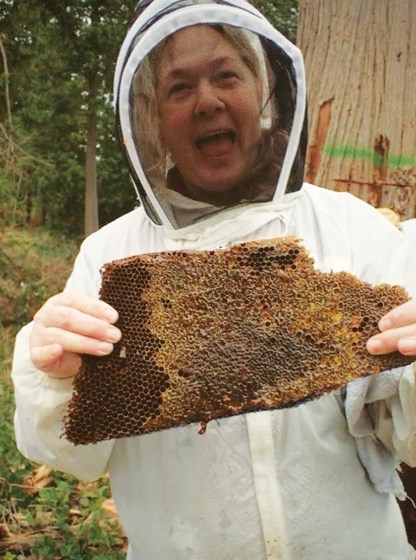A hive of up to 10,000 feral bees was saved last month in Sechelt, after a developer and real estate agent enlisted the help of a beekeeper from Roberts Creek to move the hive before the tree it was housed in was cut down.
“The land developer actually paid for the fallers to bring the tree to a point where it was safe for me to do the extraction and everybody kind of pulled together on this one,” said beekeeper Kathleen Suddes of Roberts Creek Honey.
She said she was called by real estate agent Ali Kahn in August when he and developer Jim Green noticed a swarm of bees in a tree that was to be cut down at the top of Medusa Street in Sechelt.
Green was clearing the land there for a 12-lot subdivision but didn’t want to displace or destroy the wild honeybees. It took until November to get the needed tree falling permits. Once they were in place, Suddes was called in.
“If I was a bee, I’d be in that tree. It was awesome,” said Suddes, noting rot in the centre of the tree had made it an ideal home.
“With a nice tree cavity like that, they have perfect protection. Bears can’t get them, it’s warm, it’s insulated – everything is just really good.”
Suddes explained that in the winter, the summer bees of a colony die off, leaving only the winter bees to protect the queen and keep her warm.
“What they do is they form a cluster in the wintertime and it’s like a moving football,” Suddes said.
“The cold bees on the outside are tightly packed and when they get too cold they sort of shimmy their way inside towards the middle where it’s nice and warm and the warm bees that are on the inside sort of move their way to the outside, and that’s how they keep that whole thermal regulation going.”
If bees get too cold they can die – and that was a serious concern for Suddes, who watched the weather closely in November.
On Friday, Nov. 18, the heavy November rains stopped and the sun shone for one day, so Suddes jumped on the opportunity to transport the bees.
She enlisted the help of three other beekeepers on the Coast – Martin Cook, Gigi Hoeller and Eugene Fielder – and went to the site with a special bee vacuum used for relocating swarms. After cutting open the front of the tree stump, Suddes was able to start vacuuming up the bees.
“The receiving box where the bees were all being sucked into, I had it set up with a spacer underneath and a hot water bottle and it was wrapped in a blanket, so that kept them warm,” Suddes said.
“It worked beautifully.”
After getting the bees into the receiving box, beekeepers cut the honeycombs from the tree and hung them inside hive frames. The frames were transferred into one of Suddes’ beehives and soon the bees were introduced to their new home.
They quickly took to it.
“The bees, what they do when you hive them, is they go in there and they fix up all their own comb and they clean it all up and straighten it up and they have honey in there to eat, so you just basically relocate them that way,” Suddes said.
“We got the queen, got all the bees and it worked really well. It was really, really rewarding to be able to pull those bees out and save them because that tree was coming down.”
Suddes said the feral bees may be mite-resistant, which is a sought-after trait in the beekeeping world and makes them especially valuable.
“Feral bees for beekeepers are really important because we have issues with mites in beekeeping. So I’m going to be basically rearing queens off this queen that I rescued out of the tree,” Suddes said.



